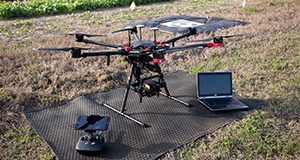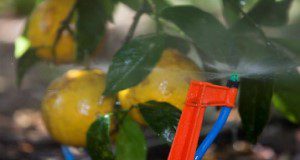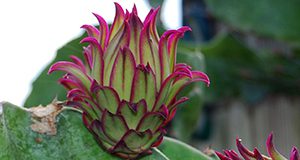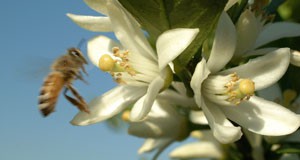Squash and pumpkin (Cucurbita spp.) are economically significant crops in Florida with over 7,900 acres in production and an estimated value of $35,412,000. Without insect pollination, however, crop yields for zucchini, crookneck, spaghetti, butternut and the rest of the large and delectable crew of squash and pumpkin species grown in Florida would be low to nonexistent. This 7-page fact sheet written by Rachel E. Mallinger and Oscar E. Liburd and published by the UF/IFAS Entomology and Nematology Department explains the pollination biology and requirements for squash and pumpkin, describes the signs and causes of poor pollination, and provides recommendations for improving pollination of these crops in Florida.
https://edis.ifas.ufl.edu/in1311
Category: Agriculture
Galling Damage to Woody Ornamentals: Diagnosis and Potential Causes
Galling or witch's broom damage on the newly expanding buds and leaves of woody ornamental plants has become increasingly common. Diagnosing this damage can be difficult because the most common causes are obscure or occur well before damage symptoms appear. This 6-page fact sheet written by Adam Dale, Erin Harlow, Carrie Harmon, and Chris Marble and published by the UF/IFAS Entomology and Nematology Department is intended to help landscape managers, nursery growers, and pest control professionals diagnose characteristic galling damage, mitigate damage that occurs, and, when possible, prevent it from occurring.
https://edis.ifas.ufl.edu/in1310
Applications of Unmanned Aerial Systems in Agricultural Operation Management: Part III: Best Practices for Efficient Aerial Surveying
With the increasing use of unmanned aerial systems (UASs) in the agricultural domain, ensuring the consistency and completeness of aerial surveys is critical in order to establish repeatability and consistency in data collection activities. This publication covers five main steps to ensure that aerial data collections are repeatable and consistent among missions. It is one of a three-part series focusing on the applications, configuration, and best practices for using UASs in agricultural operations management. Written by Aditya Singh and James Fletcher, and published by the UF/IFAS Department of Agricultural and Biological Engineering, February 2021.
https://edis.ifas.ufl.edu/ae553
Nutrition and Irrigation Management for Florida HLB-Affected Trees
To improve production of huanglongbing (HLB) affected trees, nutrition, irrigation, and soil pH should be considered together, because each can influence the efficacy of the others in overcoming the effects of HLB on tree performance. This two-sided poster published by the UF/IFAS Horticultural Sciences Department through the UF/IFAS Citrus Research and Education Center was written by Tripti Vashisth, Davie Kadyampakeni, and Jamie D. Burrow.
https://edis.ifas.ufl.edu/hs1367
Applications of Unmanned Aerial Systems in Agricultural Operation Management: Part II: Platforms and Payloads
Unmanned aerial systems (UASs, UAVs, or drones) have emerged as an important tool for farmers, Extension agents, and landowners to map, monitor, and manage their properties. This 5-page publication provides an overview of the primary components of typical UASs to help growers, landowners, and/or Extension agents who want to configure and/or purchase a UAS or sensor system for agricultural operations. This document is one of a three-part series focusing on the applications, configuration, and best practices for using UASs in agricultural operations management. Written by Aditya Singh and James Fletcher, and published by the UF/IFAS Department of Agricultural and Biological Engineering, February 2021.
https://edis.ifas.ufl.edu/ae552
Soil-Test-Based Phosphorus Recommendations for Commercial Agricultural Production in Florida
This new 6-page publication of the UF/IFAS Department of Soil and Water Sciences is intended to address agronomic and environmental issues related to phosphorus (P) dynamics in Florida agricultural soils and soil test P interpretation and management for agricultural crops. This document aims to provide science-based information to agricultural clientele, including commercial producers, small farmers, Extension agents, crop consultants, landscape professionals, representatives of the fertilizer industry, state and local agencies, students and instructors of high schools and colleges, researchers, and interested Florida citizens. Written by Rao Mylavarapu, Yuncong Li, Maria Silveira, Cheryl Mackowiak, and Mabry McCray.
https://edis.ifas.ufl.edu/ss699
The Facts about Mothballs
Mothballs are widely available for purchase and familiar to many people. However, mothballs are one of the most misused products, and their misuse can cause harmful effects to people or the environment. This new 4-page publication of the UF/IFAS Pesticide Information Office will give the basics about what mothballs are, where they can be used, and their status as a pesticide. Written by Brett W. Bultemeier.
https://edis.ifas.ufl.edu/pi289
Weed Management in Soybeans
Successful weed control is one of the most important practices for economical soybean production in Florida. This 10-page publication discusses weed control methods for soybean growers. Written by J. A. Ferrell, G. E. MacDonald, and P. Devkota, and published by the UF/IFAS Agronomy Department, revised January 2021.
https://edis.ifas.ufl.edu/wg010
Foundations of Effective Classroom Management
Classroom management can be challenging for teachers. While managing a classroom requires flexible approach, there are some basic strategies than can be used to make the classroom safe and engaging. This new 3-page article provides recommendations to teachers to manage student behavior in the agriculture classroom. Written by Kelsey M. Thornton, R. G. (Tre) Easterly III, and Ed Osborne, and published by the UF/IFAS Department of Agricultural Education and Communication.
https://edis.ifas.ufl.edu/wc381
Citrus Pest Quick Guide: Ambrosia Beetles (broadly used common name)
A one-page quick guide written by Lauren M. Diepenbrock and Jamie D. Burrow and published by the Entomology and Nematology Department presents the life cycle of the ambrosia beetle and provides several photos of the pest and the damage it causes to assist in identification.
https://edis.ifas.ufl.edu/in1283
Production Guide of Vegetable Amaranth for Florida
Vegetable amaranth is a beautiful and nutritious vegetable in the family Amaranthaceae. This vegetable has been cultivated in China for more than 400 years and has been introduced to several US states, such as Mississippi and Missouri. Florida’s mild climate combined with amaranth’s exceptional taste, nutrients, and colorful foliage suggest amaranth is a potential crop for commercial production for Florida. This new 7-page publication of the UF/IFAS Horticultural Sciences Department is intended to provide Florida growers with a production guide for vegetable amaranth to enhance its competitiveness and boost the economy by introducing this potential cash crop to growers. Written by Yuheng Qiu and Guodong Liu.
https://edis.ifas.ufl.edu/hs1407
Bacterial Spot of Pepper
Bacterial spot, caused by three species of Xanthomonas, is a limiting disease problem on all peppers. This new 4-page fact sheet provides information on symptoms, causal organism and host resistance, disease cycle and epidemiology, and disease management (including cultural and sanitation practices, chemical control measures and the use of Actigard in chile peppers). Written by Camille McAvoy, Pamela Roberts, and Jeffrey Jones, and published by the UF/IFAS Plant Pathology Department.
https://edis.ifas.ufl.edu/pp362
Management of Citrus Tree Canopies for Fresh-Fruit Production
Canopy management is a useful tool to induce precocity and maintain high production of optimum-sized, high-quality fruit. The aim of this new 8-page publication of the UF/IFAS Department of Soil and Water Sciences is to provide growers with practical tools with which to manage their trees for maximum fresh-fruit yield, quality, and profitability. Written by Andrew Krajewski, Arnold Schumann, Tim Ebert, Chris Oswalt, Rhuanito S. Ferrarezi, and Laura Waldo.
https://edis.ifas.ufl.edu/ss698
Publicly Available Geographic Information Sources and Common Analysis Tools
Geographic information and geospatial data are vital in many practical fields, including precision agriculture, natural resources management, flood zone mapping and management, and environmental assessment. This 6-page publication introduces publicly available geospatial data, including elevation, land use, soil, satellite imagery, and other thematic maps and GIS software commonly used in spatial analysis. Written by Satbyeol Shin and Young Gu Her, and published by the UF/IFAS Department of Agricultural and Biological Engineering, January 2021.
https://edis.ifas.ufl.edu/ae550
Planning and Establishing On-Farm Field Trials
Planning and preparation can increase chances of successful outcomes from demonstration plots. This 5-page publication focuses on guiding the successful establishment of demonstration trials and is targeted to county, regional, and state specialized Extension faculty who aim to develop on-farm research and demonstration sites as part of their programs. Written by Marcelo Wallau, Esteban Rios, and Ann Blount, and published by the UF/IFAS Agronomy Department, January 2021.
https://edis.ifas.ufl.edu/ag447
The Genetics of Resistance to Gastrointestinal Parasites in Florida Native Sheep
This 3-page publication provides a brief overview of resistance to gastrointestinal nematode infections in Florida Native sheep. Written by Zaira M. Estrada Reyes, Owen Rae, Carol Postley, and Raluca G. Mateescu, and published by the UF/IFAS Department of Animal Sciences, August 2020.
https://edis.ifas.ufl.edu/an361
The Passion Fruit in Florida
Passion fruit is a short-lived evergreen perennial vine that produces an aromatic and tropical-tasting fruit. This new 13-page publication of the UF/IFAS Horticultural Sciences Department provides a description of passion fruit and its various species and cultivars, as well as a guide to culture and management, harvest and storage, its pests and diseases, and food and marketing. Written by Mark Bailey, Ali Sarkhosh, Amir Rezazadeh, Joshua Anderson, Alan Chambers, and Jonathan Crane.
https://edis.ifas.ufl.edu/hs1406
Pitaya (Dragon Fruit) (Hylocereus undatus) Pests and Beneficial Insects
Pitaya or dragon fruit is a recent crop in south Florida. Dragon fruit has grown rapidly and shows a good potential for commercialization. This 13-page fact sheet written by Daniel Carriollo, Rita Duncan, and Jorge E. Peña and published by the Entomology and Nematology Department lists some of the pests and beneficial insects associated with this promising fruit crop and includes a section on control, precautions, and restrictions.
https://edis.ifas.ufl.edu/in1292
Useful Image-Based Techniques for Manual and Automatic Counting Using ImageJ for Horticultural Research
Counts (e.g., number of leaves, fruits, seeds, or plants) are a common type of data gathered in horticultural research. In many instances, using ImageJ can increase the ease and accuracy of gathering count data. When image processing can easily separate objects of interest from the background, automatic counting with ImageJ can eliminate tedious manual counting processes. Furthermore, additional plant growth data, such as leaf area, plant width, and canopy area, can be collected from the same image. The image processing and analysis techniques introduced in this article are easily accessible and simple to use and thus can be adopted not only by researchers, but also by Extension agents and students. This new 10-page publication of the UF/IFAS Horticultural Sciences Department is part of a series introducing various image-based measurements with ImageJ for horticultural research. Written by Lillian Pride and Shinsuke Agehara.
https://edis.ifas.ufl.edu/hs1405
Minimizing Honey Bee Exposure to Pesticides
To safely solve a pest problem, growers and pesticide applicators must be aware of the potential impacts of some pest-control strategies on bees, other pollinators, and beneficial arthropods. This 14-page fact sheet written by J. D. Ellis, J. Klopchin, E. Buss, and others and published by the UF/IFAS Entomology and Nematology Department explains the issue and provides strategies to protect honey bees and other beneficial insects from pesticides.
https://edis.ifas.ufl.edu/in1027


















